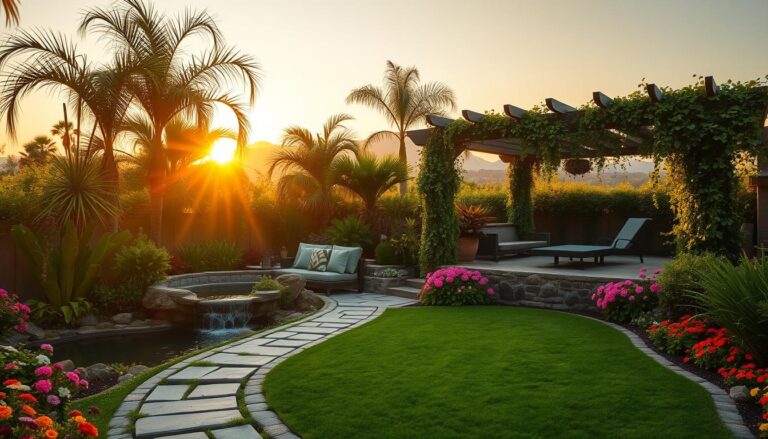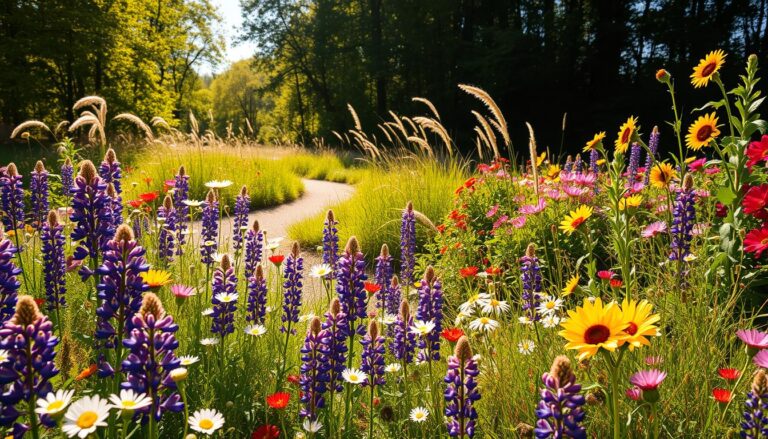Elevate Your Outdoor Space with Container Gardening
This post contains affiliate links, meaning I may receive a small commission if you make a purchase through my links, at no extra cost to you.
Want to turn your outdoor area into a stunning oasis? Container gardening is a great way to do this. It’s easy and can make any yard look better, no matter its size.
Creating a gorgeous patio garden or improving your small backyard landscaping is simple. Just pick the right plants and containers. This lets you show off your style and make your outdoor space more appealing.
Choosing the right elements can make your outdoor space feel welcoming. In this article, we’ll look at the good things about container gardening. We’ll also give you useful tips to start your own.
Key Takeaways
- Discover the benefits of container gardening for small outdoor spaces.
- Learn how to choose the right plants and containers for your patio garden.
- Get practical tips on creating a beautiful and thriving container garden.
What is Container Gardening?
Container gardening lets you grow a garden in tiny or odd-shaped spots. It’s great for city folks without big yards or traditional garden spots.
Definition and Basics
Container gardening means growing plants in pots, not in the ground. It lets you garden anywhere, from balconies to indoors. You need the right pots, plants, soil, and drainage.
Pot choices are endless, from plastic to wood and metal. Pick ones that fit your plants and style.
History and Evolution
Container gardening has been around for ages. The Egyptians, Greeks, and Romans used it for looks and food. Today, it’s all about new materials and plants.
Now, it’s a key way to green up cities. It fits modern life and cares about the planet.
Benefits for Urban Spaces
Container gardening is perfect for city living. It works in small or weird spots. You can pick the soil and avoid water problems.
It’s also great for tough spots. Poor soil or little space? No problem. It’s a smart way to beautify your space.
| Benefits | Description |
|---|---|
| Flexibility | Gardening in small or irregularly shaped areas |
| Soil Control | Ability to control soil quality and drainage |
| Aesthetic Appeal | Enhancing outdoor or indoor spaces with greenery |
Choosing the Right Containers
Choosing the right container is key for a thriving garden. The container affects your plants’ health and your outdoor space’s look.
Materials: Plastic, Clay, and Metal
Containers come in plastic, clay, and metal. Each has its own good and bad points. Plastic containers are light, easy to clean, and cheap. But they’re not as strong and can break easily.
Clay containers look natural and keep soil temperature right. But they’re heavy and can crack. Metal containers look modern but can get too hot, harming plant roots.
| Material | Pros | Cons |
|---|---|---|
| Plastic | Lightweight, easy to clean | Less durable, may become brittle |
| Clay | Natural look, regulates soil temperature | Heavy, prone to cracking |
| Metal | Modern appearance | Can get very hot in sunlight |
Size Matters: Finding the Perfect Fit
The container’s size is key for plant growth. A small container limits growth, while a large one is wasteful. Pick a size based on your plants’ mature size.
- Small containers (less than 5 gallons) are ideal for herbs, succulents, and small flowers.
- Medium containers (5-10 gallons) are suitable for most vegetables and larger flowers.
- Large containers (more than 10 gallons) are best for big plants or for creating a statement piece in your garden.
Aesthetic Considerations for Your Space
Containers can decorate your outdoor space. Think about color, texture, and style when picking. Grouping containers can also make your garden look great.

By picking the right material, size, and style, you can make a beautiful container garden. It will enhance your outdoor space.
Selecting Plants for Your Containers
Choosing the right plants for your containers is key to a thriving garden. The perfect plants can make your outdoor space beautiful, add color, and even give you fresh food for cooking.
Annuals vs. Perennials
When picking plants, think about whether to choose annuals or perennials. Annuals live for a year, blooming and then dying. They’re great for adding color and can be changed out with the seasons. Perennials come back every year, needing less care. They keep your garden looking good all the time.
For summer color, try petunias or marigolds. For a steady look, go for hostas or daylilies.
Best Plants for Sunlight vs. Shade
The sunlight your containers get is important for plant choice. For full sun (at least 6 hours of direct sunlight), pick plants like succulents, lavender, or geraniums. These plants love the sun and make your garden beautiful.
In shadier spots, choose plants that like shade. Impatiens, begonias, or ferns are good choices. They add color and texture to shady areas.
Edible Containers: Herbs and Vegetables
Growing herbs and vegetables in containers is rewarding. It gives you fresh food right at your door. For a pot herb garden, try basil, mint, or cilantro. These herbs are easy to grow and add flavor to many dishes.
For container gardening vegetables, choose tomatoes, peppers, or lettuce. These veggies do well in containers if they get enough sunlight and water.
| Plant Type | Sunlight Requirements | Container Size |
|---|---|---|
| Tomatoes | Full Sun | Large (at least 12 inches deep) |
| Basil | Partial Sun | Medium (at least 6 inches deep) |
| Ferns | Shade | Medium (at least 6 inches deep) |

Soil and Drainage Solutions
To make sure your container plants do well, focus on the soil and drainage. A good container garden needs the right soil and drainage to avoid waterlogged soil and root rot.
Importance of Quality Potting Mix
A top-notch potting mix is key for a healthy garden in containers. It should hold moisture but also let excess water drain to stop root rot. Adding compost or well-rotted manure can improve your mix.
Choose a potting mix made for container gardens. Don’t use garden soil from your yard. It can pack down and block drainage.

Enhancing Drainage Techniques
Good drainage is vital to keep the soil from getting too wet. Adding perlite or vermiculite to your mix can help. These materials make the soil more open and improve drainage.
Another trick is to put a layer of small rocks or broken pottery at the bottom of your container. This stops the mix from washing away and helps with drainage.
Using Containers with Built-in Drainage
Containers with built-in drainage systems make caring for your soil easier. These containers are made to stop waterlogging by letting excess water drain away from the roots.
When picking containers, look for ones with holes in the bottom for drainage. If your container lacks holes, you can drill some to ensure good drainage.
Maintenance of Container Gardens
Keeping your container garden healthy requires a few key steps. Regular care is essential for the success of your garden, whether it’s a small vegetable garden or a cucumber planter.
Watering Best Practices
Watering your container garden right is crucial. Too much water can cause root rot, while too little can stress your plants. Check the soil by inserting your finger up to the first knuckle. If it’s dry, it’s time to water.
Water your containers well until you see water draining out. This keeps the soil moist but not soggy. How often you water depends on the weather, soil, and plants you have.
| Plant Type | Watering Frequency |
|---|---|
| Vegetables | Daily or every other day |
| Herbs | Every other day or daily |
| Succulents | Weekly or when soil is dry |
Fertilization Tips for Healthy Growth
Fertilizing is key for a healthy container garden. Use a balanced fertilizer with equal parts nitrogen, phosphorus, and potassium.
For vegetable containers, choose a fertilizer with more phosphorus to help with fruiting. Follow the instructions on the package for the right amount.
- Use a water-soluble fertilizer for easy application.
- Fertilize during the growing season.
- Avoid overfertilizing to protect your plants.

Pest Control in Container Gardening
Pests can be a big problem in container gardens. Check your plants often for pests like aphids, whiteflies, or spider mites.
Choose organic pest control methods whenever you can. Neem oil works well against many pests. Also, introduce beneficial insects, like ladybugs, to help control pests naturally.
- Regularly check your plants for pests.
- Use neem oil or insecticidal soap to fight pests.
- Attract beneficial insects to your garden.
Creative Container Arrangements
The art of container gardening is all about the details. It’s about picking the right containers and arranging them in creative ways. By trying out different ideas, you can make your outdoor area a lively oasis.

Layering Plants for Visual Appeal
Layering plants is key to making your containers look good. Mixing plants of different heights and textures adds depth and interest. For instance, tall grasses paired with low-growing plants make a striking display.
To layer plants, start with a base plant. Then, add mid-level plants that match the base. Finally, add taller plants or grasses for height and texture. This works for both indoor and outdoor gardens, including vegetable baskets.
Color Coordination and Themes
Choosing plants with matching colors is important for a cohesive look. Think about the style you want, whether bold and bright or calm and monochromatic.
To make your garden stand out, use themed containers or add decorations like seashells or pinecones. This personal touch makes your garden unique and special.
“The garden is a love song, a duet between a human being and Mother Nature.” – Jeff Cox
Using Non-Traditional Containers
Being creative with containers can lead to amazing ideas. Try using old items like wooden crates, vintage boots, or kitchen utensils. It adds personality and reduces waste.
Make sure non-traditional containers have good drainage for healthy plants. You can drill holes or add materials like perlite or broken pottery to help.
Being creative in container gardening can transform any space into a beautiful garden. So, don’t hesitate to try new ideas and watch your garden grow.
Seasonal Considerations for Container Gardening
Changing your container gardening plan with the seasons is key to success. Container gardens need care for each season to stay alive and look great all year. Knowing what they need is crucial.

Spring Planting Tips
Spring is the best time to update your container garden. Choose plants that do well in cool spring weather, like tulips, daffodils, and pansies. Use good potting mix and make sure containers drain well.
For food containers, think about planting garlic or potatoes in buckets. Garlic is great for containers and ready to pick in early summer.
To make your spring garden look good, mix plants of different sizes and textures. This makes your garden look better and helps it grow well. Water and feed your plants often as it gets warmer.
Summer Care Routines
In summer, your garden will need more water because it’s hotter. Check the soil often and water when it’s dry on top. Feed your plants with a balanced fertilizer to help them grow and bloom.
If you have plants like herbs or veggies, make sure they get enough sunlight. Most veggies need at least 6 hours of sun a day. Watch for pests and use natural ways to keep your garden healthy.
- Water containers regularly, taking care not to overwater.
- Fertilize plants monthly to promote healthy growth.
- Monitor for pests and diseases, taking action promptly if necessary.
Preparing for Winter: What to Do
When winter comes, get your garden ready for cold. Move containers to a safe spot, like a sunny wall or under an awning, to protect them from wind and frost.
Water less as plants grow slower, but don’t let the soil dry out completely. For hardy plants, add mulch or straw to keep roots warm. For less hardy plants, bring them inside or to a greenhouse if you can.
By doing these things, you can keep your container garden healthy and lively through winter. It will be ready to bloom again in spring.
Troubleshooting Common Issues
Container gardening can be rewarding but comes with challenges. Knowing how to solve problems is key to a healthy garden. It’s important to be aware of common issues and how to fix them.
Recognizing Plant Diseases
Plant diseases are a big problem in container gardens. Look for signs like yellow leaves, black spots, or powdery mildew. For example, tomatoes in buckets might get early blight or septoria leaf spot.
Regularly check your plants and act fast to stop disease spread.

Managing Watering Mistakes
Watering mistakes are common in container gardens. Too much water can harm your plants as much as too little. Check soil moisture by feeling it with your finger.
If it’s dry, it’s time to water. For growing strawberries vertically, keep the soil moist but not soggy.
Avoid getting water on leaves to prevent fungal diseases. Water at the soil level. Consider using a drip irrigation system or soaker hose.
Knowing When to Transplant
Transplanting is important for your garden’s health. If plants have outgrown their containers or need more nutrients, it’s time to transplant. Choose a new container that’s only one to two sizes larger.
Be gentle with the roots during transplanting. For container gardening vegetables, a bigger container means more room to grow and access to more nutrients.
Inspiring Container Gardening Success Stories
Container gardening has changed outdoor spaces, bringing people together. It has created a sense of community. From small backyard projects to lively outdoor patios, it’s a favorite way to beautify cities.
Community Gardens and Shared Spaces
Community gardens have popped up in cities, offering a place for people to grow their own plants. These gardens are not just for growing food. They also become centers for community, helping people connect and feel part of something bigger.
Personal Transformations through Gardening
For many, gardening in containers has been life-changing. It gives a sense of purpose and happiness. Growing their own plants helps people appreciate nature more and feel better mentally and physically.
Container Gardens in Urban Environments
In cities, container gardening is a hit, especially for those with little space. It lets people create beautiful gardens, even in tough spots. This way, they get to enjoy the many perks of gardening in containers.
FAQ
What is container gardening?
Container gardening means growing plants in containers, not in the ground. It gives you more control over where and how plants grow.
What are the benefits of container gardening?
Container gardening lets you garden in small spaces. It also improves soil quality and drainage. Plus, you have more control over growing conditions.
What types of containers can I use for container gardening?
You can use plastic, clay, or metal containers. The choice depends on your style, the plants you want, and the look you aim for.
How do I choose the right plants for my container garden?
Think about sunlight, soil, and plant size when picking plants. Annuals and perennials work well. You can also grow herbs and veggies.
How often should I water my container garden?
Watering frequency varies by plant type, container size, and weather. Check soil moisture often and water when it’s dry about an inch down.
How can I improve drainage in my container garden?
Add perlite or vermiculite to the soil or use containers with built-in drainage. This helps prevent waterlogged soil.
What is the best way to fertilize my container garden?
Use a balanced fertilizer and follow the label. Avoid overfertilizing to prevent plant damage.
How can I control pests in my container garden?
Regularly check your plants for pests. Remove any infested plants. Use organic pest control methods as needed.
Can I grow tomatoes in a container?
Yes, you can grow tomatoes in containers. Choose a 5-gallon container, use good potting mix, and provide plant support.
How do I care for my container garden in the winter?
Protect plants from frost and reduce watering in winter. Consider moving containers indoors or to a protected area.
Can I grow strawberries vertically in a container?
Yes, you can grow strawberries vertically using a trellis. It’s a great way to save space and get a big harvest.
What are some common mistakes to avoid in container gardening?
Avoid overwatering, underwatering, and using bad potting mix. Also, make sure plants have enough support.







